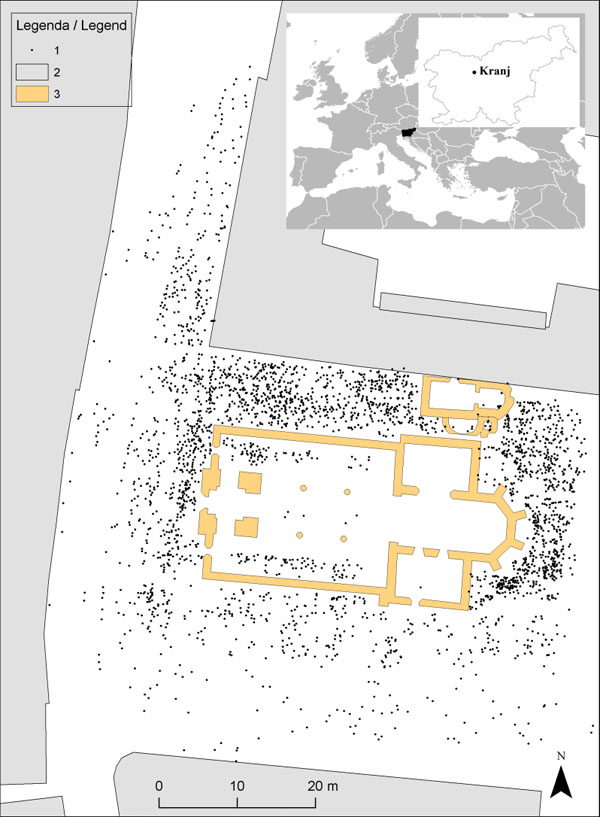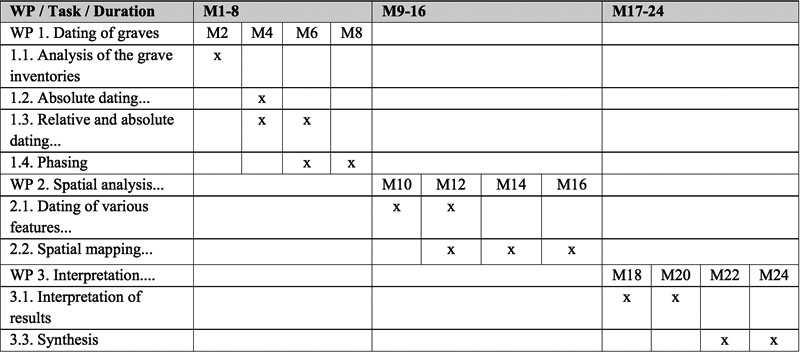Analysis of the Cemetery Župna Cerkev in Kranj (Slovenia)
Principal Investigator at ZRC SAZU
-
Original Title
Analiza grobišča Župna cerkev v Kranju (Slovenija)
Project Team
-
ARIS Project ID
Z6-4608
-
Duration
1 November 2022–30 June 2025 -
Link to SICRIS
19747 -
Project Leader
-
Financial Source
Javna agencija za raziskovalno dejavnost Republike Slovenije

Description
The cemetery of Župna Cerkev in Kranj (Slovenia) is one of the largest Early Medieval cemeteries in the south-eastern Alps as well as in the larger part of Central Europe (Fig. 1). The current state of research provides a good starting point for a qualitative leap in the archaeological knowledge of the Central European Early Middle Ages. The cemetery has 2943 archaeologically excavated graves, of which about one third are Early Medieval. A stratigraphy of the graves (Harris matrix) and a typochronology of Early Medieval jewellery and anthropological analyses have been produced. No archaeological interpretation of the cemetery has been made to date. The stratigraphy and the material remains indicate a continuous burial activity between the 8th and 18th centuries in the same area next to church buildings from different periods.
The wider area of Kranj, with its location at the junction of the Alps and the Mediterranean, shows numerous contacts with neighbouring regions, which has been repeatedly confirmed by previous research on Early Medieval material culture. Kranj (Carnium), as a place of supra-regional importance, also contains artefacts that are not typical of the area in the Early Middle Ages. In fact, similar artefacts are found in the surrounding area in the Early Middle Ages in northern Italy, Switzerland, Austria, southern and central Germany, the Czech Republic, Slovakia, Hungary, Croatia, and even sporadically in Romania. As such, the cemetery represents a unique and representative site of a significant part of Central Europe and not only of the Southeastern Alps.

Fig. 1: Cemetery Župna cerkev in Kranj. 1- Early Medieval/Medieval grave; 2-modern town; 3-High/Late Medieval church/chapel
Objectives of the project
The objective of the research is the synthetic analysis and archaeological interpretation of one of the largest Early Medieval cemetery in Central Europe. To this end, we have set 3 specific goals.
- First, dating of the Early Mediaeval and later graves with and without artefacts by applying proven archaeological and science dating methods. In particular, we use the possibility of a well-preserved stratigraphy (Harris matrix), which includes 2470 graves and 278 other elements of the cemetery, between which there are 4416 stratigraphic relations (for examples see: Fig. 2).
- Second, conducting a spatial analysis of the cemetery. Using the dated graves, we observe, in a temporal and spatial context, the distribution of the Early Medieval graves and selected attributes, as well as their relations to some other elements of the cemetery, especially the contemporary churches.
- Third, making an archaeological interpretation of the results, focusing on the Early Medieval period and supported by the results of the spatial analysis. The results provide a basis for resolving a number of interpretive issues in Central European archaeology: from questions related to archaeological typologies to problems of identity group formation and questions about the possibility of detecting population migrations.
To achieve the goals, we have divided the workflow into the following three work packages (WP 1- 3):
WP 1: Dating of graves;
WP 2: Spatial analysis of the cemetery;
WP 3: Interpretation of the cemetery.
M - month of project duration

- RIHTER, Jernej, RIHTER, Boštjan 2024, Digitalno orodje za analizo srednjeveških grobišč z obsežno stratigrafijo: primer grobišča Župna cerkev v Kranju = A digital tool for analysing Medieval cemeteries with extensive stratigraphy : the case study of the Župna Cerkve Cemetery in Kranj (Slovenia). Arheo : arheološka obvestila. dec. 2024, [št.] 41, str. 7-30. DOI: 10.5281/zenodo.14380423
- RIHTER, Jernej 2024, Chronological remarks on Early Medieval jewellery and evidence for pilgrimage : the case study of the Župna Cerkev cemetery in Kranj (Slovenia),. V: VARGHA, Mária (ur.), ŠTEFAN, Ivo (ur.). Power in numbers : state formation and Christianization on the eastern edge of Europe. Turnhout: Brepols, cop. 2024. Str. 155-175, ilustr., načrta, tabele. Borders, boundaries, landscapes, 4. ISBN 978-2-503-60861-7, ISBN 2-503-60861-2. ISSN 2736-6871. DOI: 10.1484/M.BBL-EB.5.138114
- RIHTER, J. 2023, Stratigrafsko najstarejši zgodnjesrednjeveški grobovi in začetek pokopavanja na grobišču Župna cerkev v Kranju (Stratigraphically lowest early medieval graves and beginnings of burial in the Župna cerkev cemetery in Kranj (Slovenia)). − Arheološki vestnik 74, 263–308; DOI: https://doi.org/10.3986/AV.74.08
- RIHTER, Jernej, Analysis of the cemetery Župna Cerkev in Kranj (Slovenia). Preliminary observations of the research project / Analiza grobišča Župna cerkev v Kranju. Predhodne ugotovitve raziskovalnega projekta. V: KOPRIVNIK, Vesna (ur.), SALECL, Dunja (ur.). Srečanja tisočletij = The convergence of millennia : Museoeurope : the collected volume of the symposium 19.-21. 10. 2023 : [= Zbornik mednarodnega simpozija 19.–21. 10. 2023]. Maribor: Pokrajinski muzej: = Regional Museum, 2023. Str. 333-344, ilustr. Zbirka Museoeurope, 8. ISBN 978-961-94532-7-8. https://museum-mb.si/wp-content/uploads/2023/10/MuseoEurope_2023.pdf. [COBISS.SI-ID 171768323]